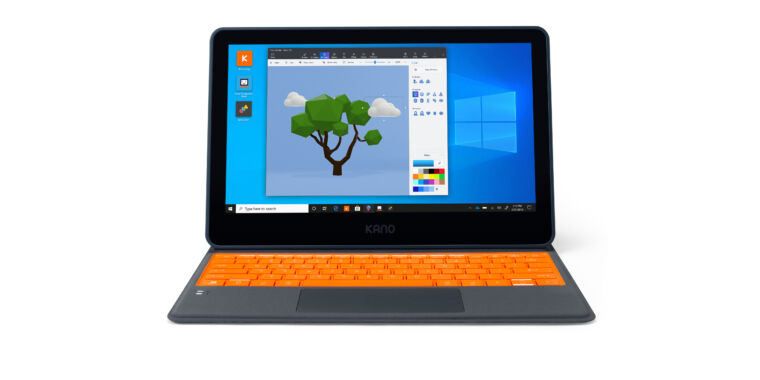
-
The Kano PC offers similar specs to this year's Chromebooks at a similar price—but it runs Windows, not ChromeOS.
-
This is the back view of a fully assembled Kano PC. Note the clear case and the battery plugged in via USB.Kano
-
The Kano PC ships disassembled—you and your kids can snap it together somewhat like Legos.Kano
-
Kano claims many things of the Kano PC. "Sleek" is not one of them, as this sideview demonstrates—its modularity comes at a price.Kano
Last June, educational software and hardware vendor Kano announced an ambitious new project: a build-your-own computer kit based on x86 hardware and Windows 10. This replaces similar products Kano has offered for years, based on the Raspberry Pi. The finished product, designed in partnership with Microsoft, launched launched today.
The Kano PC, retailing for $299, is an 11.6-inch touchscreen two-in-one design, usable as either tablet or laptop—although it's a Windows system, it most strongly resembles an extremely chunky Android tablet in a folding case with a built-in keyboard. The case includes a built-in stand to prop the screen up at a landscape viewing angle, as well as the integrated keyboard and touchpad.
The Kano PC ships with Windows 10 Home in S Mode and is powered by an Intel Celeron N4000 CPU, 4GB of DDR3L RAM, and 64GB eMMC storage. It also has a microSD card slot for adding storage later. Wi-Fi connectivity is included, but it's not stellar—the specs describe it as dual-band b/g/n, with Bluetooth 5.0. Resolution on the touchscreen is 1366x768, and video can be pushed to an external display via an HDMI port. The system also offers two USB 3.0 ports, one USB-C port, and three audio jacks (two out, one in).
Kid-friendly
The Kano PC is cheerfully and unashamedly targeted to kids, with bright colors and plastic everywhere. But the best part about the system is likely to be its modular design—the reason it's so chunky is that the major components snap together somewhat like Legos and can be individually replaced (and, eventually, upgraded).
The back of Kano PC's case is transparent, so kids can see what's inside even after it's assembled, and it should be pretty rugged. Kano says the screen "withstands a steel ball dropped from six feet"—although it doesn't specify how large that steel ball is.
Kano hopes that the device will compete with Chromebooks to become the primary device for students in classrooms, rather than being relegated to a single oddball device in the corner. Running a full Windows operating system—even if in S mode—does offer more flexibility than ChromeOS, but that flexibility is a dual-edged sword. Students may be able to learn more from devices which aren't as tightly locked down as a Chromebook, but they also have far more opportunity to render them unusable due to malware or misconfiguration.
It's hard to say what the Kano PC's real performance will feel like until we get our hands on one to test—and, yes, we've retail-ordered one to review here soon. Kano provided Novabench with results that position the Kano PC well north of a $350 Acer Spin 11—which shouldn't come as much of a surprise, since the Spin 11 uses a Celeron N3350 instead of the Kano's N4000.
Although we aren't particularly familiar with Novabench, it's reassuring to see that the Kano PC's specified CPU score of 225 is slightly higher than the N4000's average CPU score of 212. This is a strong indicator that we won't be seeing any EVOO-style underclocking shenanigans keeping the little Celeron from performing to its full potential.The Kano PC is available today through the company's store, Best Buy, and the Microsoft Store, with in-store stock expected in Best Buy locations across the United States and Canada soon.
Listing image by Kano
Technology - Latest - Google News
July 15, 2020 at 03:43AM
https://ift.tt/2ZtuXmb
It’s modular, it’s cheap, it runs Windows—it’s the $300 Kano tablet PC - Ars Technica
Technology - Latest - Google News
https://ift.tt/2AaD5dD
Shoes Man Tutorial
Pos News Update
Meme Update
Korean Entertainment News
Japan News Update
Bagikan Berita Ini















0 Response to "It’s modular, it’s cheap, it runs Windows—it’s the $300 Kano tablet PC - Ars Technica"
Post a Comment